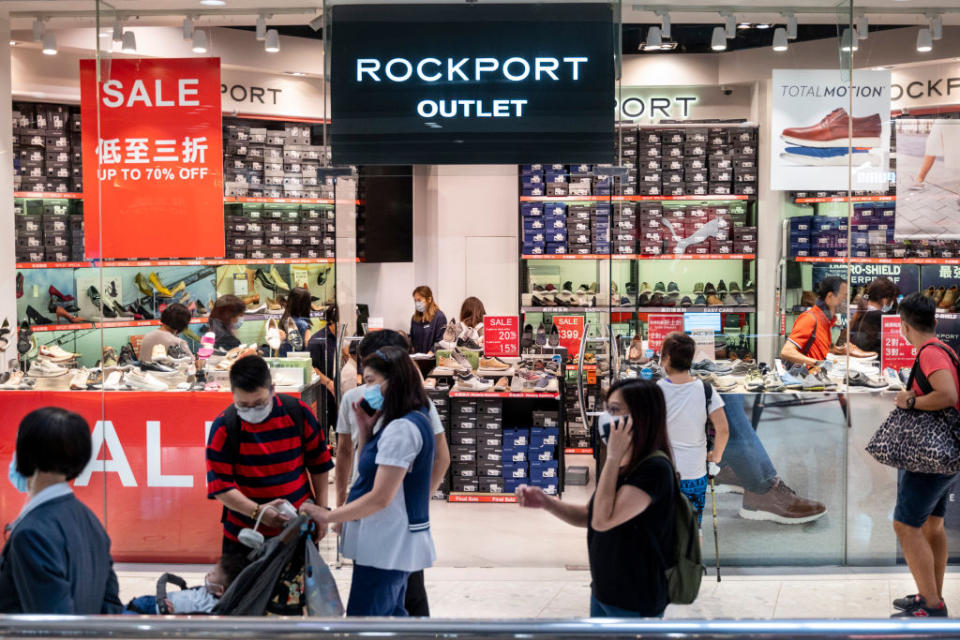Is Chapter 22 This Year’s Biggest Bankruptcy Trend?

There’s a new bankruptcy trend emerging this year.
While the takeaway from new S&P Global Market Intelligence data is that the 15 bankruptcies through the end of May were five times higher than what the same 2022 period brought, several deeply troubled retailers are filing for bankruptcy a second time around after failing to effectively reorg after their first collapse.
More from Sourcing Journal
$191,000 Fine for New England Trio's False Made in USA Claims
Retailer Whose CEO Appeared on 'Undercover Boss' Acquiring Near-Bankrupt Forman Mills: Report
Though the three retailers that have filed bankruptcy petitions in the first five months of 2023 might be a reason for optimism, players in apparel could find themselves at greater risk. The S&P data shows apparel retail’s default risk climbing to 4.5 percent as of June 13 from 4.3 percent a month ago. Retailers in the broadlines (4.2 percent from 5.7 percent) and accessories and luxury goods (2.7 percent from 3.7 percent) sectors seem to be in better shape at the moment. Like apparel, the challenged home furnishings sector is on shaky ground, with its default risk inching up to 3.7 percent from 3.4 percent.
The one-year default probability declined for most retail categories, except for a modest rise for home furnishings, apparel and specialty retailers, according to S&P.
Chapter 22
A closer look at the bankruptcy data reveals an unusual number of companies filing for a second time in what’s known in bankruptcy slang as a Chapter 22. This usually occurs when a first bankruptcy fixed the balance sheet but failed to overhaul operational deficiencies.
S&P’s 15-retailer bankruptcy list includes two in the footwear sector. Rockport Company filed on June 14 for its second bankruptcy after Shoe City’s parent company filed earlier in the year. The Chapter 11 bankruptcies of David’s Bridal and off-price home goods retailer Tuesday Morning earned them entry into the Chapter 22 club.
The only surprise with Bed Bath & Beyond Inc.’s April 23 bankruptcy was how long it took the Union, N.J. home goods chain to file after problems escalated last year, including the jarring death of its chief financial officer. Party City‘s bankruptcy came early this year, but the chain’s distressed balance sheet and lengthy history of losses had long put the seller of balloons, costumes and more on credit watch lists. Ironically, onetime Bed Bath & Beyond property Christmas Tree Shops followed in its former owner’s ill-fated financial footsteps by filing for bankruptcy early last month. Bed Bath & Beyond, however, has had luck selling some of its assets to Overstock.com, and a Buybuy Baby auction on Wednesday could bring in even more funds.

Elsewhere in fashion commerce, Retailing Enterprises LLC filed for bankruptcy on May 30. The catalog retailer operates the fashion banners Anthony Richards and Complements, in addition to other properties.
The mattress business has also seen its fair share of bankruptcy action this year. Though not on S&P’s list because it isn’t a retailer, Serta Simmons Bedding filed a pre-packaged bankruptcy petition in January after months of speculation.
Mattress Firm parent Steinhoff International Holdings received creditor support for the debt restructuring plan it hopes will keep it out of bankruptcy, and a Dutch court reportedly approved a plan to let creditors control the company. Steinhoff holds a 45 percent stake in Mattress Firm and a 79 percent stake in Europen apparel retailer Pepco.
Mattress Firm went private under Steinhoff in 2016, but filed for bankruptcy in 2018 and emerged one month later. After scrapping IPO plans in January, Mattress Firm Group is set to be acquired by Tempur Sealy International Inc. in a $4-billion-plus cash-and-stock deal that’s expected to close in late 2024.
International players are falling on hard times, too. Dutch brand Sandwich went into administration, i.e., bankruptcy, in February though parent company Veldhoven International B.V. previously went bankrupt in November 2019. Amsterdam-based men’s and women’s lifestyle brand Scotch & Soda also fell into administration in March.
In the U.K., companies that entered administration in June include Hunter Boot, best known for its Wellington boots, and fashion house Christopher Kane Ltd. Brand management firm Authentic Brands Group has already bought Hunter’s IP assets, while the future for Christopher Kane is unclear—options include finding an investor, a buyer or even a shutdown of the business.
Who to watch
Luxury consignment retailer The RealReal, contemporary fashion brand Vince Holding Corp and Express Inc. have long been on credit watch lists for a possible bankruptcy filing. The money-losing online home retailer Wayfair and the online digitally native fashion brand holding platform A.K.A. Brands Holding Corp. have been cited by some credit specialists as well.
However, Express Inc.‘s $400 million licensing deal with brand management firm WHP Global in December gives it a bit of breathing room, while Vince’s strategic partnership with Authentic Brands Group in April likely accomplishes the same result. And the highly distressed Forman Mills, an off-price fashion retailer, received a reprieve last week when Shoppers World agreed to buy the chain after warning that a bankruptcy was likely if it couldn’t find a buyer.
The RealReal managed to post a narrower first quarter loss, but its future is still up for debate. Winding down beauty sales and its direct business is expected to help the bottom line, as is a greater focus on consignment where margins are higher.

Retail Ecommerce Ventures (REV) could see its fortunes change, too. Known for rebooting troubled brick-and-mortar brands as lean-and-mean digital players, it controls Pier 1, Linens ‘n Things, Dressbarn, Stein Mart and Modell’s Sporting Goods. But the $32 million lifeline it gave Tuesday Morning in September wasn’t enough to stave off the off-price home goods seller’s bankruptcy this year. REV is believed to be considering bankruptcy among other options after it missed some debt payments this spring.
What about the rest of 2023?
Echoing the S&P findings, Michael Appel, managing director at Getzler Henrich & Assocs., said the home sector is in worse shape than apparel. The restructuring expert doesn’t expect many more bankruptcies before the end of the year because those in the worst shape have already filed. Borderline companies can probably hang on through the holiday season, unless something specific to their financial obligations pushes them over the edge, Appel said.
While credit has tightened, ongoing inflation could eat into consumer spending, creating cash-flow problems for retailers struggling with both financial and operational challenges.
U.S. discretionary retail sales fell 7 percent year-on-year in March, while unit sales were down 8 percent, according to a study from Circana, formerly IRI and The NPD Group. Last month UBS softlines analyst Jay Sole flagged apparel as the “most discretionary category” in today’s inflation-ravaged economy. He believes the softlines spending environment will have a tough go of it in the next six to 12 months.

